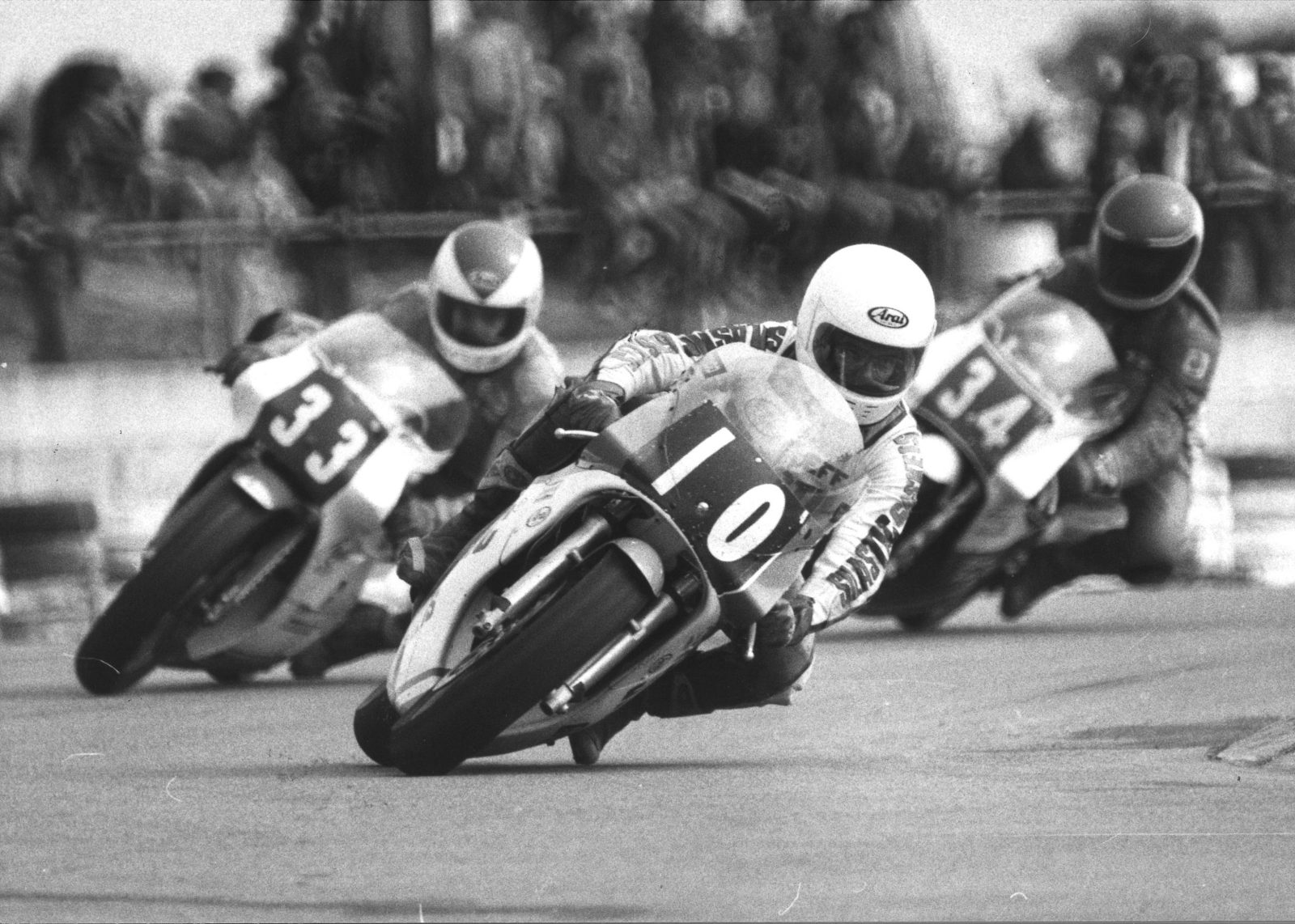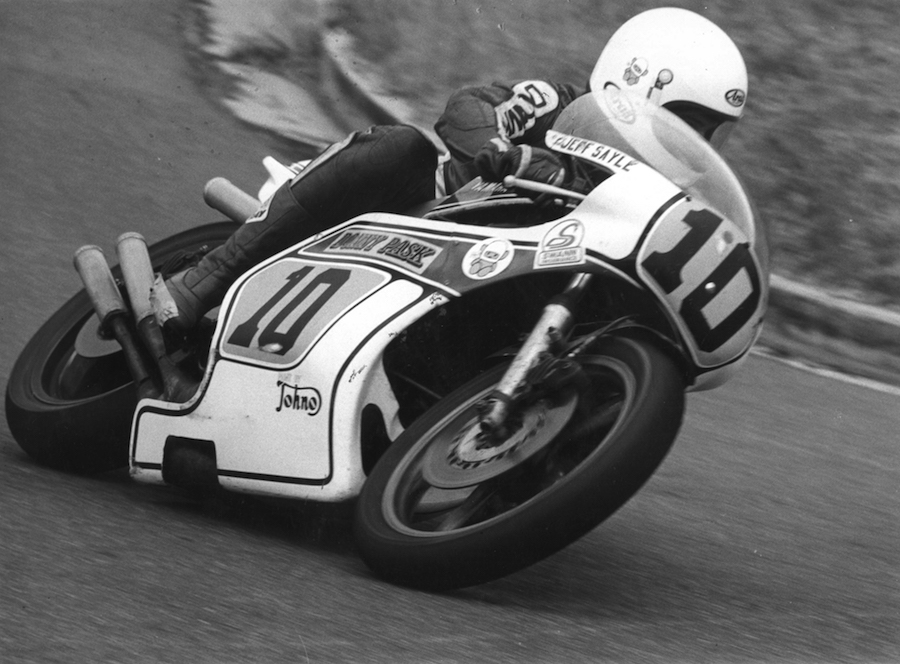Four decades ago, a throng of Aussie racing talent bit the bullet and headed to Europe to try their luck
A group of Australians gather around Warren Willing’s Yamaha TZ750 at the Imola 200 meeting of April 1-2, 1978. They’re full of expectation, five riders tackling Europe full-time, two more on short tours, as well as support crew and 12-year Continental Circus campaigner John Dodds.
It is an iconic image. Former Kiwi racer Stu Avant reckons it’s the best photo ever taken of Australian racing history, capturing so much of the period. Former AMCN editor Bob Guntrip says it gives him a lump in the throat every time he looks at it; a snapshot of a generation.
It was a talented group, the Class of 1978, one of the strongest to head overseas together.
If we only list their best domestic achievements in the previous two seasons, we have the 1977 Australian road-racing champions in the Unlimited, 500, 350 and 250 classes, the 1977 Australian 350 and 250 Grand Prix winner, two podium finishers in the ’77 Australian Unlimited GP, the winners of the 1976 Australian Unlimited, 500, 350 and 250 titles, the 1976 Australian Unlimited and 500 TT winners, 1976 and ’77 Oran Park Formula 750 Pro Series winners, one of the 1977 Castrol Six-Hour victors, and a back-to-back Adelaide Three-Hour winner.

The racers in the photo, shown on the opening spread, are (left-to-right): Ray Quincey, Graeme McGregor, Greg Johnson, Gregg Hansford, Kenny Blake, Jeff Sayle, Warren Willing and John Dodds.
With them are Willing’s sponsor/mechanic Alan Adams, veteran mechanic Dave Hall, Johnson’s partner Lynne, Sayle’s mechanic Mick Smith, Team Kawasaki Australia manager Neville Doyle, and experienced GP mechanic Lionel Angel.
We can’t put a name to the man on the extreme left, nor can we be sure of the photographer.
In case you’re wondering about the chalk board Kenny Blake is holding, people were scouring the paddock for him to join the photo and thought the sign would help!
More Australians were present that weekend, but missing from the photograph – Jack Findlay as a rider, and Kel Carruthers, back in Europe seven years after his GP riding days to manage Kenny Roberts’ assault on the GPs and world Formula 750 championship. Imola was the opening F750 round.
Vic Soussan was also in Europe, continuing his 250/350 GP career. Two weeks earlier, he and Hansford had competed in the season-opening Venezuelan GP. Hansford had also been to Daytona, winning the 100-mile 250cc race at an average speed of 100mph.
Ray Quincey says the photo fills him with mixed emotions. “I think of the guys who are no longer with us – Gregg, Warren, Kenny and Dave Hall – that hits me first,” he said.
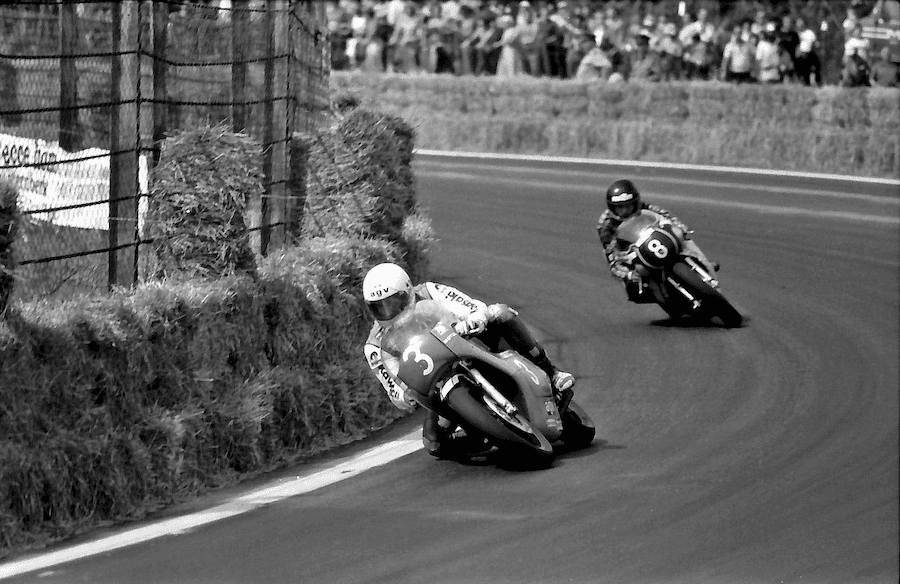
“We were a group of guys who did what we could under the circumstances; a very talented group and great guys.
“Gregg proved himself by finishing second in the world 250 championship twice and dicing with Kenny Roberts. Jeff was always a respected rival, with title potential. I remember being in Italy in 1980 and watching Assen on television, seeing Jeff finish fourth in the 350 GP. Warren was a great developer of machines. Kenny Blake was a very talented and lovely guy who probably went away years too late, and Greg Johnson helped me with my bikes here.”
As a group, 16,000km from home, they pitched in for each other, the 250 racers helping with refuelling stops for the F750 riders.
Indeed, the sense of collective began before they left for Europe, when Blake, Hansford, Johnson, Quincey and Sayle were granted a civic farewell at Melbourne Town Hall.
“I was the only one wearing a tie, because my mother insisted,” Quincey recalled. “The Lord Mayor (Irvin Rockman) presented us with official 1978 diaries and The Herald newspaper ran a photograph. We were guys with expectations, off on a great adventure.”
Top local drawcards Hansford and Willing had gained significant international experience in the preceding four years, with summer tours to New Zealand and trips to major F750 events, including Daytona, Laguna Seca, Ontario (California), Imola, Paul Ricard, Charlotte, San Carlos (Venezuela) and Mosport (Canada).
Willing had already ridden a season in Europe as a private entrant, having declined a Yamaha offer of a factory bike to race in Australia in 1977, and instead head overseas with future wife Wendy and American mechanic George Vukmanovich. Willing rode Bathurst at Easter 1978 and then made a brief trip to Europe with Adams.
Hansford carried the highest hopes, after winning just about everything at home and impressing in his international 750 and 250 appearances. Surely now for the GPs, though this wasn’t confirmed in the press until the middle of January 1978.
However, team manager Doyle said the plan was hatched during the second half of 1977, when Kawasaki told him it would supply machines for Hansford to contest the 250 and 350 GPs in 1978 and ’79, and provide some help with budget.
Doyle said the main financial support came from Australia and “it was a similar story with (key rival) Kork Ballington, who was funded by the English distributor”.
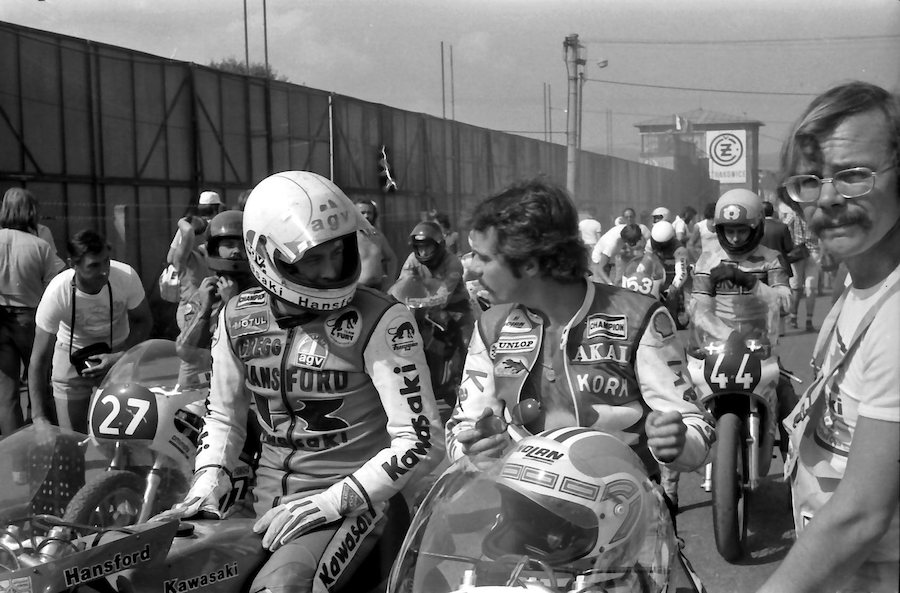
Gregg Kork and Dozy on dummy grid at Brno
Racing fans worldwide had every reason to be excited about 1978, with Roberts set to take on twice champion Barry Sheene, Johnny Cecotto and rising US star Pat Hennen for the 500 title, and a potential three-way 250 contest, involving GP rookies Roberts and Hansford, with four-times GP winner Ballington on factory machines for the first time. Cecotto, Hansford and Roberts would also face off in the world F750 championship.
But there were other Australians with ambitions to travel, including Sayle – Hansford’s leading domestic rival through 1977.
Sayle was one of a number of Australians who broadened their experience in the New Zealand international summer racing series. His interest was sparked by tagging along when elder brother Murray and Warren Willing used their winnings from the 1972 Castrol Six-Hour 250 Class to cross the ditch – a year before the international series began in December 1973.
Willing and the Sayles gained plenty from these trips. Four or five meetings close together sharpened their riding, gave them new competition against the top Kiwis and visiting Americans, and fired the thought of racing on a bigger stage. They became familiar faces in NZ in December-January.
Jeff Sayle’s progress at home saw him riding a Yamaha TZ750D and Suzuki RG500 Mk II for Gold Coast motorcycle dealer Donny Pask in 1977. He rode 32 meetings that year, finishing second to Hansford in the national championship, and winning both the national 500 crown and the three-meeting Oran Park F750 series. He then won the 1977-78 NZ series, ahead of brother Murray Sayle and Willing.
This was achieved in serious company, including works Yamaha rider Hideo Kanaya, future world 500 champion Marco Lucchinelli and America’s Wes Cooley, as well as Stu Avant, Trevor Discombe, Rick Perry, Ray Quincey, John Woodley and Graeme Crosby on the Hannan-Kawasaki Z1-R Superbike.
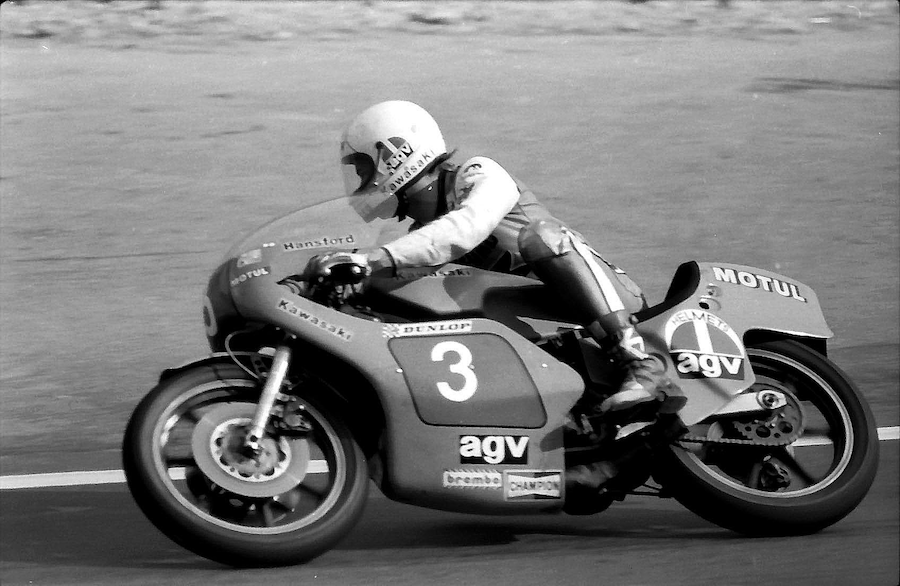
Gregg Kork
But it’s who you meet too, and Jeff Sayle said he wouldn’t have gone in 1978 without input from English journalist Andrew McKinnon, who covered the NZ series for weekly publication Motor Cycle News. McKinnon encouraged Sayle to travel and found him an English sponsor, who bought air tickets to London for Sayle and Quincey.
Quincey had family tradition too. His father, Maurie, raced in Europe in 1954. Ray, who was named after works Norton rider Ray Amm, was an infant with his parents at the Isle of Man in June 1955 when a mechanical failure pitched Maurie down the road, ending his international career.
McKinnon also talked with McGregor, so Graeme linked up with Sayle and Smith to ride in the support races at England’s three major Easter meetings, and the F750 championship rounds at Imola and Circuit Paul Ricard.
There was a New Zealand connection for Blake too, having competed against English racer Chas Mortimer there for two summers. Mortimer offered Blake a bike for 1978 and transported it in his truck, which was driven to meetings by mechanic Lionel Angel.
Johnson was to have raced in Europe in ’78 with support from Jack Walters and Ron Angel (no relation to Lionel), but pressed on under his own steam.
The Imola crew did not take long to make their marks, and four of them returned in 1979.
Blake won an international on an Austrian airfield the following weekend, while Hansford recorded his first GP victory the week after that at Jarama, where Quincey made his GP debut and finished ninth.
Hansford went on to win another six GPs that year, including double victories in France, Sweden and Yugoslavia. At the time, his feats were records for an Australian rider, eclipsing Tom Phillis’s six victories and two doubles in 1961.
Hansford was runner-up in the 250 world championship and third in the 350 title. He also won the first leg of the world F750 round at Assen.
Johnson finished fourth in a world F750 championship race at Zeltweg (now the Red Bull Ring) and won an international at Salzburgring.
Sayle was sixth in a Formula 750 championship race at Brands Hatch and at the end of the year rode with Hansford for the Rest of the World team in the AGV Nations Cup. He also impressed at the North-West 200, Isle of Man TT and some major meetings in England before coming home and winning the inaugural Swann Insurance International Series.
Sadly, Ray Quincey crashed at a street-circuit race at Sint-Joris-ten-Distel in Belgium on August 13 when the throttle slides of his machine stuck open and he was left paralysed.

Dodds and Findlay both retired from racing at the end of 1978. Dodds had been racing in Europe since 1966. He had already set up home in Germany and still lives there.
Findlay had gone to England in 1958. After he retired, he had a long stint as a motorcycle tyre tester for Michelin. In 1992 he was appointed FIM technical director for Grand Prix racing, a job he only left at the end of 2001 at age 66 when emphysema made it too difficult for him to fly. He died in France in 2007.
There were more Australian world travellers in 1978 than those assembled that day at Imola.
At the end of July, Tony Hatton and Kiwi Graeme Crosby finished third in the inaugural Suzuka Eight-Hour on a Moriwaki-Kawasaki superbike, after leading the race and running out of fuel. July in Japan is brutally humid, but Hatton pushed the machine to the pits to keep them in the hunt.
Another event in Japan, the Sugo Big Road Race, featured Willing and Murray Sayle riding as guests of Yamaha on TZ750s. They finished one-two.
In September 1978, Ross Hannan entered Hatton and Crosby for a second crack at the Bol d’Or 24-Hours, this time at Paul Ricard in the south of France, and with a specially commissioned prototype chassis. They failed to finish. A week later, Crosby rode for a British team in the 1000km Coupe d’Endurance round at Brands Hatch, finishing seventh in his first race in the UK.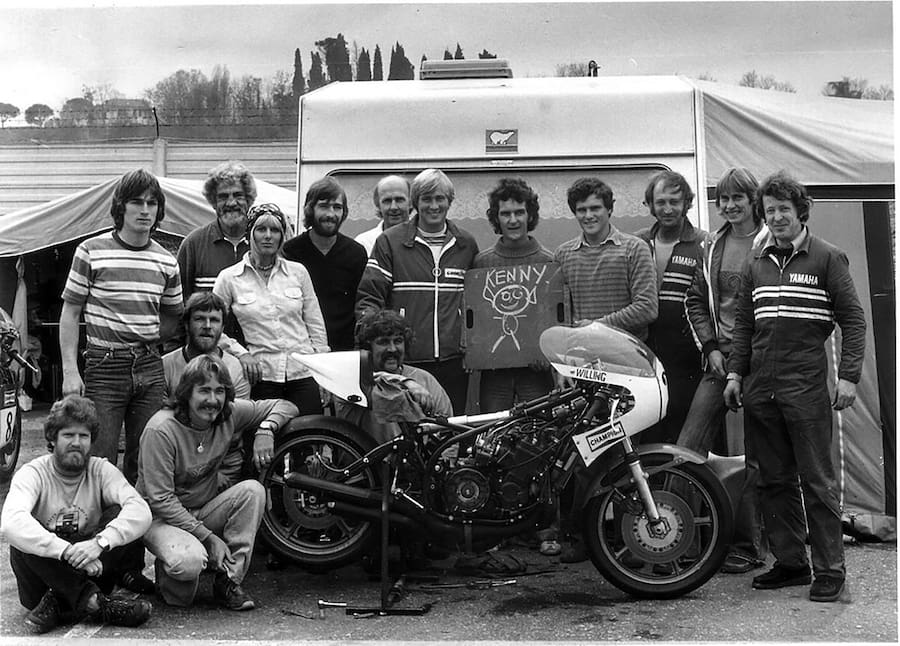
There were more Australians on tour in 1979. Willing entered a contract with English sponsor Sid Griffiths, and with Alan Adams to prepare machines for Griffiths’ other riders, including (for 1979) Blake. Willing’s riding career ended in Northern Ireland in late May 1979, in a horrific crash that almost cost him his left leg.
Murray Sayle, having won the 1978 Australian Unlimited championship, joined his brother on tour in ’79. McGregor went for the full season, as did Vaughan Coburn, Rick Walden and sidecar racer Peter Campbell.

Two years after Ron Walker was Lord Mayor, Blake, Johnson, Hansford, Quincey (in tie) and Sayle are sent off at the Melbourne Town Hall
Crosby rode in Britain on Mamoru Moriwaki’s four strokes and made a few international F750 appearances on a Kawasaki KR750 provided by Neville Doyle. Barry Smith, a three-time GP winner in the 1960s, returned to the Isle of Man TT and Europe for the first time since 1969, winning the World TT Formula Three crown on a machine he developed and the Belgian 125 GP on a bike Jack Walters bought. Brian Smith, another 1960s private entrant and not related to Barry, also returned to the TT.
Meantime, in endurance racing, Mick Cole and Tony Hatton won the second Suzuka Eight-Hour on a Honda Racing Service Center machine. That victory prompted RSC to enter them in the 1979 Bol d’Or. Cole crashed during testing and broke his leg, so Blake was called in. The two wily Australians were in contention to win until their machine suffered gearbox problems. They were credited with eighth place.
Now for the sobering part.
Kenny Blake died at the Isle of Man in June 1981. A month later, Hansford had a crash in Belgium that ruined his motorcycle-racing career. He died in a car-racing crash at Phillip Island in March 1995. Willing died from cancer in September 2015.

Blake
Sayle and Smith
Jeff Sayle’s career received a major boost in 1977 when his sponsor bought a new Yamaha TZ750D, based on the previous year’s works 0W31 racers.
Now he could battle with mate and rival Gregg Hansford of Team Kawasaki Australia.
Sayle also linked up with mechanic Mick Smith, who had been schooled by Robert Hinton, the youngest of three racing Hinton brothers. Sayle paid $5200 for a new Yamaha TZ750E in 1978 and they went to Europe.
“I went because Gregg went,” Sayle said. “But I wouldn’t have gone that year without Andrew McKinnon organising an air ticket through (English sponsor) Montgomery Swan. Ray Quincey received the same deal.”
Sayle makes some interesting comments on the affects of homesickness and maintaining morale during a long season.
“Gregg was so brilliant he had to go, but he hated being there. I loved it.
“Some guys did better in their first seasons than they realised. Greg Johnson had good results in 1978. In 1980, Greg Pretty had really good results in the Trans-Atlantic support races.
“I had an argument with Croz a year after I first went, telling him he should go. I said, ‘You’ve just got to get yourself over there – you’re good enough.’ The (four-stroke) TT Formula One thing was happening, it was good timing for him.
“You’ve got to be able to handle all contingencies. Maybe some guys had it too good here and struggled as a result.”
Sayle said he knew about Jack Findlay, but went to a lot of meetings before he met the veteran private entrant. “But I got on well with Kel Carruthers and John Dodds. With Kel, it was so easy and he was so helpful.”
Smith said there had been no discussion about going to Europe before the NZ series.
“The cream on the cake was Jeffrey winning the series,” Smith said. “He was riding Donny Pask’s bike really well, but winning in New Zealand gave him some international credibility.
“He was a damn fine motorbike rider and I’m glad he got the opportunity, because Gregg and Warren had gone away.”
Smith said the ‘78 Imola meeting was like going to Oran Park, with so many Aussies there: “What a group. It was the good old days, with Macca (McGregor) and Ray Quincey. I had been around a bit (Smith was 29), but I was quite excited about it.
“The thing you have to adjust to is that you go from being a big fish in a small pond here to a little fish there, where people you’ve never heard of smack your arse. And everywhere you go – Brands Hatch, Snetterton and such – there are local track experts.
“I thought in ’78 that if we could get some momentum, we’ll be alright and that’s how it worked out. Jeffrey soldiered on and got reasonable results – enough to interest a new sponsor and go back the following year.
“It was an adventure and I enjoyed it, as I did all my involvement in racing, with the Hintons, Jeffrey and beyond.”
Smith went on to work for the Suzuki GB team and manage Team Honda Australia. Sayle rode in Europe until 1983 and was a podium GP finisher. He continued racing until 1989.
Words Don Cox Photography Rob Lewis and AMCN archives
